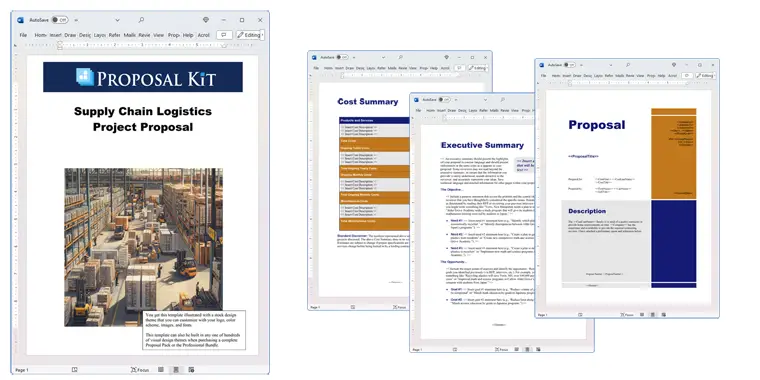How to write your Supply Chain Logistics Project Proposal
We include this 19 page layout with every Proposal Pack. If you want this template to have a different visual design theme than the one illustrated here, purchase any Proposal Pack design and create this template using the purchased design theme. This template is included in every Proposal Pack. If you get a Proposal Pack or the Professional, you can also make any variation of this template with different chapters to suit your needs.
We typically include more chapters in the templates than most people will need to give everyone more variety in the chapters they may need. You can trim down a long template by removing pages you do not need or combining multiple chapter topics into one page.
 DOWNLOADABLE, ONE-TIME COST, NO SUBSCRIPTION FEES
DOWNLOADABLE, ONE-TIME COST, NO SUBSCRIPTION FEESYou can also create countless variations of this document to suit your needs using the included library of 2200+ chapters if ordering a Proposal Pack or Professional.
 What Our Clients Say
What Our Clients SayThe proposal pack is simple to use and a true time saver. At the end of the day, time is money! Great product!"
Operations and Events Manager
Soiree Planners
Vancouver, Canada
Related Article
Related Video
Related Templates
- Transportation Logistics Project Proposal
- Supply Chain Disruption and Risk Report
- Raw Material Supply Proposal
- Shifting Production from Commercial to Consumer Proposal
- Manufacturing and Distribution Proposal
- Transportation Shipping Services Proposal
- Request for Proposal (RFP) Equipment Supply
- PPE Shortages Report
- Medical Equipment Distribution and Sales Proposal
- Relocate Manufacturing Domestic Proposal
- Beverage Distributor Product Sales Proposal
- Product Supply RFP Response Proposal
- Transportation of Hazardous Waste Proposal
- Medical Equipment Supply and Transportation Proposal
- Petroleum Product Supply Proposal
- Outsource Supply Production Locally Proposal
- Raw Material and Spare Parts Supply Proposal
- Logistics Research Project Proposal
- Sanitary Transportation Food Safety Proposal
- Minimizing Tariff Exposure Proposal Template
- Inventory Management Proposal Template
- Supply Chain Optimization Proposal Template
- Logistics and Shipping Services Proposal Template
- Moving Transportation Services Proposal
- Vaccine Production and Distribution Proposal
- Inventory Management Project Proposal
- Procurement and Consignment Services Proposal
- Logistics Services Proposal Template
- Customs Clearance and Forwarding Proposal Template
- Oil Tanker Business Proposal
- Import Export Services Proposal
What's the best way to write your supply chain logistics project proposal?
A proven solution for creating your supply chain logistics proposal is using the Proposal Kit template and software package. Proposal Kit provides an extensive array of templates tailored to meet the demands of a supply chain logistics project. These templates are not only comprehensive but also adaptable, ensuring that every unique business requirement is addressed. Furthermore, the software integrates a sophisticated line item quoting database system. This feature allows you to effortlessly generate cost summaries, quotes, estimates, and budgets and cover other financial topics of your proposal.
Do you need to write a proposal for a supply chain logistics project? The Proposal Kit is designed for you.
What Types of Projects Are Supply Chain Logistics Project Proposals Written For?
Supply chain logistics proposals are crucial for a wide range of projects where efficient logistics and supply management play a vital role. These are examples of situations where detailed proposals are written:
- Warehouse automation and robotics integration
- International shipping and customs facilitation
- Transportation and distribution network optimization
- Supply chain risk management and contingency planning
- Inventory management system implementation
- Vendor and supplier relationship management
- Cold chain logistics enhancement
- E-commerce fulfillment center establishment
- Reverse logistics and return management
- Just-in-time (JIT) inventory systems
- Lean supply chain initiatives
- Cross-docking facility development
- Freight forwarding services
- Green logistics and sustainability projects
- End-to-end supply chain visibility systems
- Supply chain cybersecurity improvements
- Cooperative logistics partnerships
- Outsourcing logistics operations
- Fleet management and route planning
- Demand forecasting tools and technology
Chapters this template is built with
Creating a supply chain proposal requires a customized approach, as no single premade template fits all situations. The Proposal Kit is designed to create variations of templates that are suited to any situation. Below is a starting point of chapters that can be customized using the Proposal Kit's extensive library of thousands of chapters and its document creation software. This list represents just a small selection of the extensive array of templates available, allowing you to customize your proposal to cover all necessary topics.
Cover Letter
The cover letter serves as the introduction to your proposal, providing a glimpse into the purpose and goals of your supply chain logistics project. It sets the stage and invites the reader to explore the details within. In this context, the cover letter could explain the critical importance of optimizing logistics processes to reduce costs and improve delivery times, enticing the reader to look further into your proposal.
Executive Summary
The executive summary offers a snapshot of the entire proposal, highlighting key points and benefits of your logistics project. It is created to quickly convey the value of your proposal to decision-makers. Here, you can emphasize how your proposed strategies will enhance efficiency, reduce waste, and ultimately increase profitability for the client.
Cost Summary
A detailed cost summary provides an overview of the financial topics, including budgets and expected expenditures. It helps stakeholders understand the financial commitment required for the project. For a supply chain logistics project, this section would break down costs associated with technology upgrades, personnel training, and anticipated savings through process improvements.
Needs Assessment
The needs assessment identifies the specific challenges and requirements that the logistics project aims to address. This section justifies the necessity of the proposal, focusing on the benefits it brings. In a logistics context, this might include recognizing issues such as bottlenecks in distribution channels or outdated inventory systems and modern solutions.
Goals and Objectives
Clearly defined goals and objectives outline what the project intends to achieve. This section establishes measurable targets and helps align stakeholder expectations. For instance, objectives can be set to reduce supply chain lead times by a specific percentage or implement a new warehouse management system within a defined timeframe.
Resource Management
Resource management covers the allocation and optimization of resources, including personnel, equipment, and technology, ensuring the project's success. Specific to logistics, this might involve detailing plans for reallocating staff to critical areas or investing in new software tools to track shipments more.
Project Management
Project management details the timeline, milestones, and methodologies to be employed, providing a roadmap for successful project execution. In logistics, you might outline phases for implementing new tracking systems, along with key milestones for when each phase should be completed.
Recommendations
The recommendations section offers expert advice on the best strategies and solutions for the logistics project, backed by analysis and insights. This could include suggesting the adoption of automation technologies or the restructuring of supply chain partnerships to enhance efficiency and reduce costs.
Capacity
Capacity analysis evaluates the ability of your organization to meet the demands of the logistics project, addressing potential limitations and opportunities. You might assess current warehouse capacities and suggest expansions or enhancements to accommodate growing demand.
Qualifications
The qualifications section highlights the expertise and experience of your team, reinforcing the credibility of your proposal. Here, you would showcase your team's past successes in similar logistics projects, emphasizing their ability to deliver results on time and within budget.
Company History
A brief overview of your company's history and achievements builds trust and showcases your track record in delivering successful logistics solutions. You could focus on past innovations your company has brought to the logistics field and how these have benefited other clients.
Reliability
Reliability underscores your organization's commitment to quality and consistency, assuring stakeholders of dependable project execution. In logistics, this means demonstrating your ability to maintain service levels even during peak demand or unforeseen challenges.
Logistics
The logistics section outlines the strategies and operations planned for managing the supply chain, focusing on efficiency and optimization. This might include the implementation of real-time tracking technologies and strategies for minimizing transportation costs.
Supply Chain
The supply chain details the end-to-end flow of goods and services, providing insights into the processes and systems involved. Here, you would map out the entire supply chain, identifying areas for improvement and enhancements to streamline operations.
Facilities
The facilities description covers the infrastructure and capabilities available to support the logistics project, emphasizing readiness and suitability. This could involve detailing the current state of warehouse facilities and any planned upgrades to support new logistics strategies.
Distribution
Distribution plans highlight the methods and channels for delivering products or services, ensuring timely and effective reach to the market. This section might focus on developing new distribution partnerships or optimizing existing routes to cut down on delivery times and costs.
Use cases for this template
Optimizing Delivery Routes for Success
The Challenge
GlobalTransit Solutions, a logistics provider, faced challenges with its distribution network. Inefficiencies in delivery routes resulted in delays and escalating costs, causing dissatisfaction among clients. The team struggled to articulate their solutions in proposals, which hampered their ability to secure new contracts.
The Solution
Seeking a structured approach, the team turned to Proposal Kit. With access to a extensive array of templates specifically designed for logistics projects, GlobalTransit Solutions found the tools they needed to articulate their strategies clearly and professionally. The templates offered a solid foundation to showcase their innovative distribution solutions.
The Implementation
Using the Proposal Kit, the team customized the templates to fit their unique strategies. They created a detailed proposal that highlighted optimized distribution strategies, complete with cost summaries, resource management plans, and timelines. The proposal addressed client concerns, demonstrating how the solutions would reduce costs and improve delivery efficiency.
The Outcome
The comprehensive and well-structured proposal captured the attention of stakeholders, leading to a significant contract acquisition. This success not only enhanced GlobalTransit Solutions' reputation in the industry but also positioned them as a leader in effective distribution solutions. The new contract brought increased business, further solidifying their market presence.
Racing Against Time: Meeting the Proposal Deadline
The Challenge
Emma, a project manager at TechNest Innovations, faced a tight deadline to write a proposal for an internal logistics optimization project. The pressure was immense, as she needed to quickly assemble a document to secure project approval from the board. With limited time and resources, she needed an efficient and reliable solution.
The Solution
Emma turned to Proposal Kit for assistance. The templates provided a comprehensive framework, ensuring she didn't miss critical details. To further expedite the process, she used an AI writing tool to quickly generate content, focusing on the needs assessment, cost analysis, and logistics management sections.
The Implementation
By integrating the Proposal Kit's templates with AI-generated content, Emma created a detailed and persuasive proposal. The structured format allowed her to clearly convey the project's objectives, benefits, and anticipated outcomes. The use of AI helped her populate the document quickly, ensuring all sections were thorough and well-drafted.
The Outcome
Emma submitted the proposal on time, and it was met with enthusiasm by the board. The clear and concise presentation of the logistics optimization strategy led to immediate project approval. Emma's ability to meet the deadline was recognized and praised, showcasing her as a proactive and efficient project manager ready to tackle future challenges.
Driving Sustainability in Non-Profit Supply Chains
The Challenge
Daniel, a director at GreenPath Initiatives, was tasked with writing a Request for Proposal (RFP) for sustainable supply chain solutions. The non-profit aimed to attract partners who shared their commitment to environmental responsibility. Daniel needed a comprehensive proposal to clearly convey their vision and requirements.
The Solution
Daniel chose the Proposal Kit to help structure the RFP. The extensive library of templates provided a strong foundation for creating a detailed and compelling document. The templates guided him in addressing key topics such as sustainability goals, resource allocation, and logistics strategies.
The Implementation
By customizing the Proposal Kit templates, Daniel was able to produce an RFP that emphasized GreenPath's dedication to sustainable practices. The proposal clearly outlined their objectives, the expected impact of the solutions, and the criteria for potential partners. He ensured that the document resonated with companies that valued environmental sustainability.
The Outcome
The RFP generated significant interest, attracting several reputable companies eager to collaborate with GreenPath Initiatives. The organization successfully partnered with a firm that aligned with its sustainability goals. This partnership not only advanced GreenPath's mission but also set a precedent for future projects, showcasing the power of well-written proposals in achieving objectives.
Conclusions and Recommendations
With Proposal Kit's templates and software, you have a proven solution at your disposal. From initial drafts to final submissions, Proposal Kit assists you every step of the way, ensuring your proposal is comprehensive, professional, and tailored to your project's unique needs. Whether you're optimizing distribution networks, meeting tight deadlines, or elevating non-profit supply chains, Proposal Kit helps you write winning proposals with ease.
Also Known As
This template may also be referred to in different ways or be used in more specialized situations, such as:
- Supply Chain Project Proposal
- Logistics Optimization Proposal
- Distribution Network Proposal
- Freight Management Proposal
- Warehouse Management Proposal
- Inventory Control Proposal
- Supply Network Proposal
- Logistics Strategy Proposal
- Transport Solutions Proposal
- Vendor Management Proposal
Abstract
 An effective logistics business proposal is important for organizations aiming to improve their supply chain management and optimize current supply chain processes. In today s competitive market, streamlining processes and enhancing supply chain operations can provide a significant advantage by improving collaboration between key stakeholders such as manufacturers, shippers, procurement specialists, and warehousing teams. A comprehensive project plan should address key performance indicators, inventory levels, scheduling, procurement, and the assignment of roles to ensure that repetitive tasks are minimized and resources are used efficiently. Using new technologies and data-driven research can expand capabilities, improve communication, and help oversee complex logistics networks while maintaining customer satisfaction.
An effective logistics business proposal is important for organizations aiming to improve their supply chain management and optimize current supply chain processes. In today s competitive market, streamlining processes and enhancing supply chain operations can provide a significant advantage by improving collaboration between key stakeholders such as manufacturers, shippers, procurement specialists, and warehousing teams. A comprehensive project plan should address key performance indicators, inventory levels, scheduling, procurement, and the assignment of roles to ensure that repetitive tasks are minimized and resources are used efficiently. Using new technologies and data-driven research can expand capabilities, improve communication, and help oversee complex logistics networks while maintaining customer satisfaction.
Clearly defined documentation, robust communication strategies, and transparency in purchasing and funding are important to measure success and fulfill promises to customers and other parties involved. A well-written proposal outlines adjustments needed to minimize disruptions, maintain optimal inventory levels, and support productivity. It should also include sections on qualifications, resource allocation, and related templates and links to reinforce credibility and improve competitiveness.
Investment in the right tools and responsible management ensures that logistics operations efficiently connect products with their destinations, meeting expectations for timely delivery while allowing for adjustments based on feedback and performance metrics. By addressing the effectiveness of supply chain processes, warehousing, and distribution strategies, organizations can make informed decisions, hire the right personnel, and pay close attention to key stakeholders needs, ultimately leading to improved customer satisfaction and operational excellence.
 In supply chain management, organizations often face the challenge of coordinating multiple parties while aiming to streamline processes and minimize disruptions throughout their operations. Creating a logistics business proposal that accounts for these complexities requires not only clarity in documentation and resource planning but also investment in solutions that can adapt as the supply chain advances over the course of a project. Assigning roles with precision and using best practices ensures that each stakeholder understands their responsibilities, which both supports collaboration and strengthens accountability across the supply chain.
In supply chain management, organizations often face the challenge of coordinating multiple parties while aiming to streamline processes and minimize disruptions throughout their operations. Creating a logistics business proposal that accounts for these complexities requires not only clarity in documentation and resource planning but also investment in solutions that can adapt as the supply chain advances over the course of a project. Assigning roles with precision and using best practices ensures that each stakeholder understands their responsibilities, which both supports collaboration and strengthens accountability across the supply chain.
Proposal Kit offers a valuable framework for assembling these proposals by providing content libraries, automated quoting systems, and related templates that can be customized to meet the unique demands of each project. By guiding users through the process of building a comprehensive project plan, Proposal Kit helps organizations efficiently address important topics such as procurement, warehousing, communication strategies, and performance measurement. The inclusion of related links and references within proposals can further support decision-making by connecting key stakeholders to additional resources, industry standards, and supporting documentation.
A well-developed logistics proposal not only contributes to minimizing disruptions but also helps optimize investment in technology and infrastructure, ensuring that all parties involved work toward shared goals. Ultimately, using advanced tools and structured templates helps organizations to fulfill their promises to customers, maintain competitiveness, and deliver solutions that meet the demands of supply chain operations.
 In addition to addressing the technical and operational topics of supply chain processes, successful logistics business proposals must also focus on the human and organizational topics that drive project success. Assigning roles with clear definitions helps ensure that each party involved, from procurement officers to warehousing staff and external shippers, knows their specific responsibilities and how they contribute to the overall objectives. This clarity reduces misunderstandings, accelerates decision-making, and allows each party to collaborate more toward shared outcomes.
In addition to addressing the technical and operational topics of supply chain processes, successful logistics business proposals must also focus on the human and organizational topics that drive project success. Assigning roles with clear definitions helps ensure that each party involved, from procurement officers to warehousing staff and external shippers, knows their specific responsibilities and how they contribute to the overall objectives. This clarity reduces misunderstandings, accelerates decision-making, and allows each party to collaborate more toward shared outcomes.
Recognizing that every party in the supply chain - whether internal team members or third-party vendors - plays a unique and crucial part in the chain s performance, proposals should highlight strategies for integrating these roles seamlessly. Well-defined responsibilities facilitate smoother transitions between project phases and bolster accountability, while regular feedback and performance assessments support ongoing improvements. By emphasizing the importance of collaboration and mutual understanding between all parties, organizations can create an environment where supply chain disruptions are minimized and project goals are more readily achieved. This holistic approach not only supports better outcomes for customers but also strengthens long-term relationships among all involved in the supply chain ecosystem.
Frequently Asked Questions
What should be included in a supply chain proposal?
A supply chain proposal should encompass several key components to ensure a comprehensive presentation. It typically includes an executive summary, a detailed needs assessment, goals and objectives, and a cost summary. Additionally, resources management and project management plans should be addressed. These sections collectively allow stakeholders to understand the project's scope, the challenges it aims to solve, and how it will be executed. By using these topics, the proposal can clearly convey the benefits and expected outcomes to potential clients or partners.
How do I tailor a supply chain proposal to specific client needs?
To tailor a supply chain proposal to specific client needs, it's crucial to first conduct a thorough needs assessment. This involves understanding the client's unique challenges and requirements. By using Proposal Kit's customizable templates, you can adjust each section to address these specific needs. For example, if a client is focused on reducing transportation costs, emphasizing cost-effective logistics solutions and strategies in your proposal will resonate with them. By aligning your proposal with their priorities, you increase the likelihood of a successful bid.
What role does a cost summary play in a supply chain proposal?
In a supply chain proposal, the cost summary plays a role in outlining the financial topics of the project. It provides a breakdown of expected costs, including materials, labor, technology, and other related expenses. This section is vital for potential clients or stakeholders as it illustrates the financial feasibility and value of the project. A well-prepared cost summary can differentiate your proposal by demonstrating transparency and thorough financial planning, which are crucial factors in decision-making processes.
How can I ensure my supply chain proposal is competitive?
To ensure your supply chain proposal is competitive, focus on showcasing your unique value propositions. Highlight your team's expertise, past successful projects, and innovative solutions tailored to the client's needs. Incorporating a detailed project management plan and solid resource allocation strategy can further strengthen your proposal. Additionally, using Proposal Kit's templates can help you present a professional and polished document, which is important in leaving a lasting impression on potential clients or partners.
What common mistakes should I avoid when writing a supply chain proposal?
When writing a supply chain proposal, common mistakes to avoid include lacking clarity on the project's objectives, underestimating project costs, and failing to align the proposal with the client's specific needs. It's also important to avoid using overly technical language that may not be easily understood by all stakeholders. Ensure that the proposal is concise, well-organized, and visually appealing. Double-checking for errors and inconsistencies is crucial, as a polished and error-free proposal reflects your attention to detail and professionalism.
20% Off Discount
![]() Add To Cart This Word Template
Add To Cart This Word Template
 Add To Cart Proposal Pack for Any Business
Add To Cart Proposal Pack for Any Business
 Add To Cart Proposal Kit Professional
Add To Cart Proposal Kit Professional
 4.7 stars, based on 849 reviews
4.7 stars, based on 849 reviewsProposal Kit chapters used in this template
Cover Letter, Title Page, Table of Contents, Executive Summary, Needs Assessment, Goals and Objectives, Project Management, Resource Management, Logistics, Supply Chain, Distribution, Facilities, Reliability, Capacity, Cost Summary, Recommendations, Company History, Qualifications, Back Page
Line Item Automated Chapters
If you purchase a Proposal Pack or the Professional Bundle, these proposal pages are generated using an automated line-item database in the included Wizard software.
Cost Summary
You use this proposal for
- General business proposal
- Non-technical proposal
- Project pitch proposal
- Transportation, logistics proposal
How to create this template with Proposal Pack Wizard
You can create this document using any of the logo-designed Proposal Packs. Pick any Proposal Pack with a logo design theme you like best; they will all work equally well. The Proposal Pack for Any Business is the pack with no extra added logos or colors - designed to be used plain or for you to customize with your logos and graphics.
The Proposal Pack design theme you purchase will determine the visual look of this template. The screenshot above only shows the plain generic design theme.
We include a library of chapters to be assembled based on your needs. All proposals are different and have different needs and goals. We designed Proposal Pack so you can customize the documents to suit your needs.
You will best create this document using the Proposal Pack Wizard - Expert Edition software to select this template and build it in the Proposal Pack logo design theme of your choice along with any desired customizations (such as adding additional chapters, removing unneeded chapters, changing the order of chapters, and importing your company logo). This template outlines a proposal for the described situation. Each user is responsible for typing in the actual content of the provided pages with their information to complete the proposal. Suggestions in the abstract may include features in higher-end packages and are facilitated by the selection of chapter templates to support the narrative of each proposal, which help guide the user in filling in the details.
The Wizard software's AI Writer will write the content of the pages of the template based on details provided for your company, client, project, financial details and other writing instructions. This will provide a personalized version of the template completely written and ready to edit.
Once finished, the AI Writer's Word-to-PowerPoint converter can transform your proposal, business plan, or other business documents into a PowerPoint slideshow. Save time and effort by letting the AI analyze every chapter to condense its content into talking points, visually matching the document, and providing a consistent package of presentation material with the click of a button.
You create this template using the Wizard software with an entire Proposal Pack library and software. We include the Expert Edition of the software in the Proposal Kit Professional. Microsoft Word for Windows is required to use the customizing software. You can also edit Word document templates in other office software such as Word for Mac. We will assist Mac users in assembling complex templates for their first project if they do not have the required platform to run the Wizard software.
How to Build Templates Featured on Proposal Kit Website
Many people find the Proposal Kit website after searching for a specific proposal. Once you've purchased and installed the software, how do you build that template you found in the first place? This video shows you how to build any proposal you see on the Proposal Kit website.
 Ian Lauder has been helping businesses write their proposals and contracts for two decades. Ian is the owner and founder of Proposal Kit, one of the original sources of business proposal and contract software products started in 1997.
Ian Lauder has been helping businesses write their proposals and contracts for two decades. Ian is the owner and founder of Proposal Kit, one of the original sources of business proposal and contract software products started in 1997.By Ian Lauder
 Published by Proposal Kit, Inc.
Published by Proposal Kit, Inc.


 Cart
Cart
 Get 20% off ordering today:
Get 20% off ordering today: 


 Facebook
Facebook YouTube
YouTube Bluesky
Bluesky Search Site
Search Site